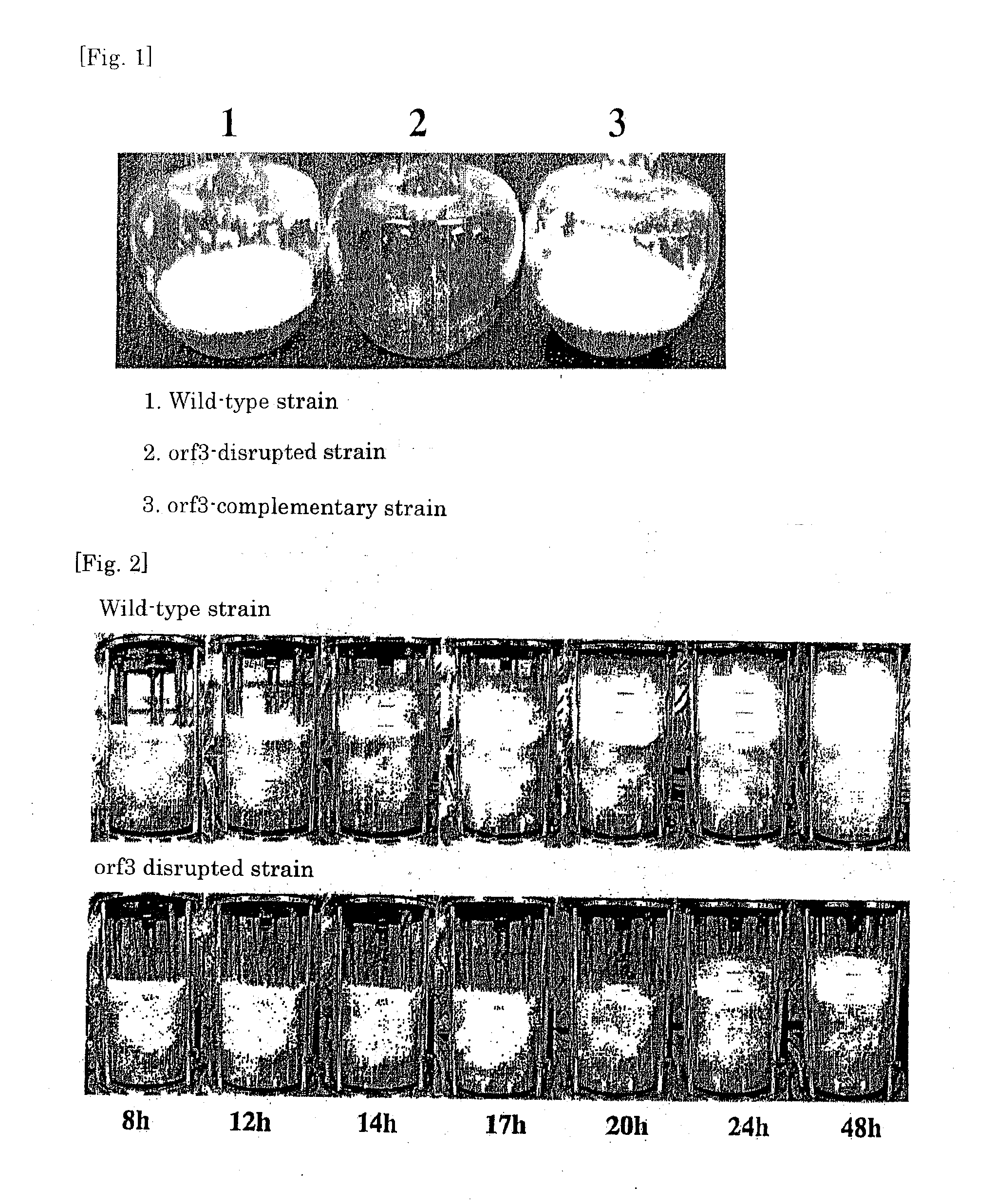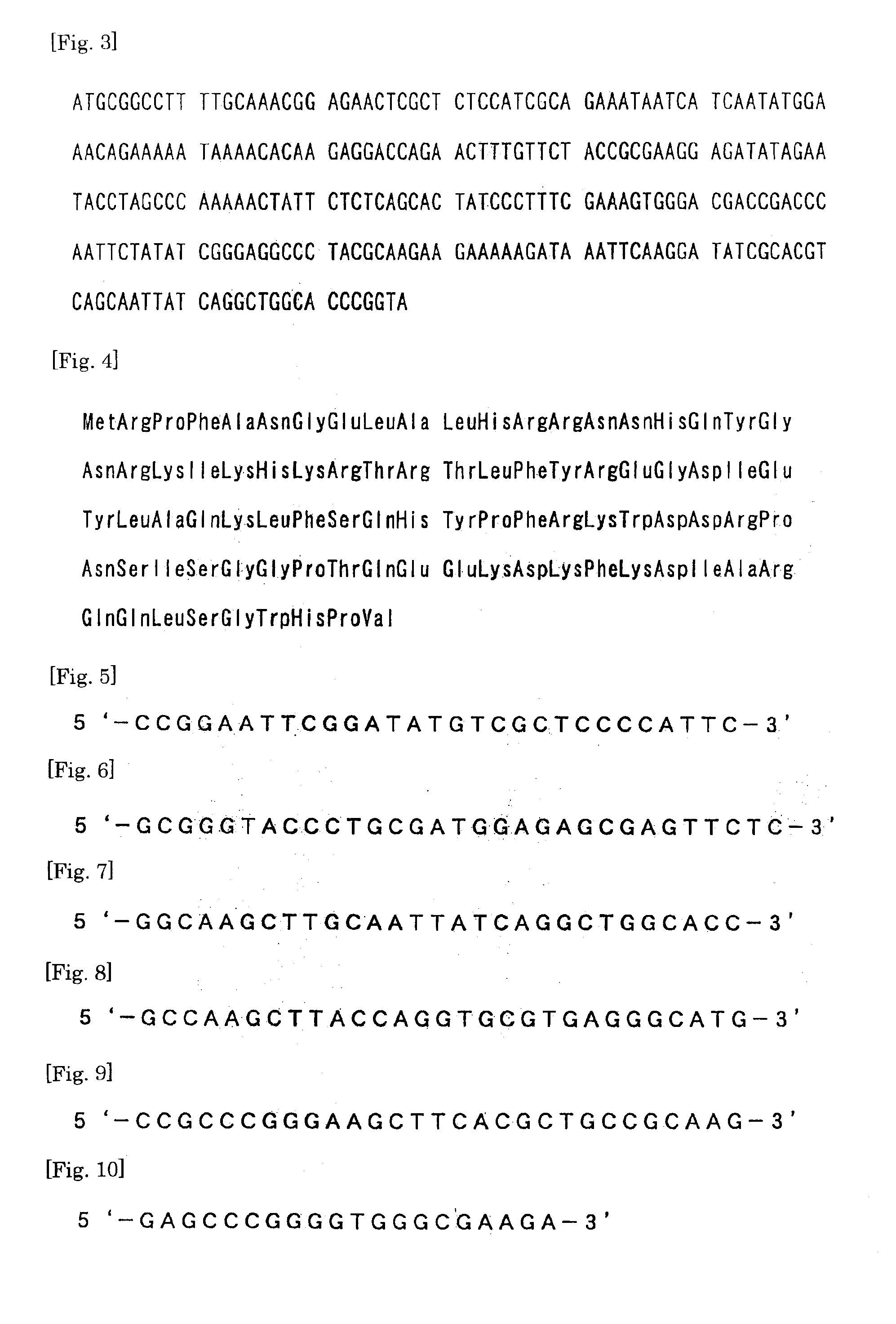Gene associated with foam formation of acetic acid bacterium, acetic acid bacterium bred by modifying the gene and method for producing vinegar using the acetic acid bacterium
a technology of acetic acid bacterium and gene, which is applied in the direction of peptide/protein ingredients, transferases, peptide sources, etc., can solve the problems of not all reporter strains brought success, and the cloning of genes involved in a quorum sensing system failed, so as to achieve significant suppression of foam formation, reduce or delete the function of a protein encoded, the effect of reducing the number o
- Summary
- Abstract
- Description
- Claims
- Application Information
AI Technical Summary
Benefits of technology
Problems solved by technology
Method used
Image
Examples
example 1
Gene Involved in Foam Formation
[0072]Since foam formation in the culture broth occurs at a later stage of the culture, it was thought that foam formation might be under the control of the quorum-sensing system which is a transcriptional regulation system depending on bacterial cell density. Therefore, the foaming ability of Gluconacetobacter intermedius NCI 1051Δorf1 (hereinafter may be referred to as orf1-disrupted strain) and Gluconacetobacter intermedius NCI-1051Δorf2 (hereinafter may be referred to as orf2-disrupted strain) were respectively compared to the foaming ability of Gluconacetobacter intermedius NCI 1051 (herein after may be referred to as wild-type strain). Here, the Gluconacetobacter intermedius NCI 1051Δorf1 in which a gene encoding the acyl homoserine lactone synthase is disrupted is a strain derived from Gluconacetobacter intermedius NCI 1051 that was deposited under the Budapest Treaty on Jan. 31, 2007 with the International Patent Organism Depositary at the Nati...
example 2
Strain in which the Gene Involved in Foam Formation is Disrupted
[0077]In Example 1, orf3 was suggested to be a gene involved in foam formation. Therefore, a orf3-disrupted strain was prepared to examine the involvement of orf3 in foam formation. Namely, using primer 1 (see FIG. 5 and SEQ ID NO: 3 in the sequence listing) and primer 2 (see FIG. 6 and SEQ ID NO: 4 in the sequence listing) which were synthesized based on the nucleotide sequence of orf3, an upstream sequence and 5′-side sequence of orf1 was amplified by PCR method with the chromosomal DNA of Gluconacetobacter intermedius NCI 1051 as a template, and the amplified product was treated with the restriction enzymes EcoRI and KpnI (TAKARA BIC INC.) to prepare a DNA fragment (DNA fragment 1) .
[0078]Similarly, using primer 3 (see FIG. 7 and SEQ ID NO: 5 in the sequence listing) and primer 4 (see FIG. 8 and SEQ ID NO: 6 in the sequence listing) which were synthesized, a 3′-side sequence and downstream sequence of orf1 was amplif...
example 3
Foaming Suppressing Ability of the orf3-Disrupted Strain
[0084]The orf3-disrupted strain obtained in Example 2 in which the orf3 gene had been disrupted was compared to a wild-type strain for the foaming ability. Specifically, a shaking culture was carried out at 30° C. and 120 rpm in a medium (100 ml) containing 2% ethanol, 3% glucose, 0.5% yeast extract, 0.3% polypeptone, 100 μg / ml ampicillin, and 1% Celluclast 1.5 L (Novozymes) by using a Sakaguchi flask of 500 ml volume. The result demonstrated that foam formation was significantly suppressed in the orf3-disrupted strain as compared to the wild-type strain (FIG. 1). A complementary strain of orf3 was prepared to confirm this result. Consequently, it was confirmed that the phenotype was restored (FIG. 1).
PUM
| Property | Measurement | Unit |
|---|---|---|
| Fraction | aaaaa | aaaaa |
Abstract
Description
Claims
Application Information
 Login to View More
Login to View More - R&D
- Intellectual Property
- Life Sciences
- Materials
- Tech Scout
- Unparalleled Data Quality
- Higher Quality Content
- 60% Fewer Hallucinations
Browse by: Latest US Patents, China's latest patents, Technical Efficacy Thesaurus, Application Domain, Technology Topic, Popular Technical Reports.
© 2025 PatSnap. All rights reserved.Legal|Privacy policy|Modern Slavery Act Transparency Statement|Sitemap|About US| Contact US: help@patsnap.com


